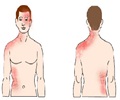- Acosta EP, Balfour HH. Acyclovir for Treatment of Postherpetic Neuralgia: Efficacy and Pharmacokinetics. Antimicrobial Agents and Chemotherapy. 2001;45(10):2771-2774.
- Sampathkumar P, Drage LA, Martin DP. Herpes Zoster (Shingles) and Postherpetic Neuralgia. Mayo Clinic Proceedings. 2009;84(3):274-280.
- De Bony F, Tod M, Bidault R, On NT, Posner J, Rolan P. Multiple Interactions of Cimetidine and Probenecid with Valaciclovir and Its Metabolite Acyclovir. Antimicrobial Agents and Chemotherapy. 2002;46(2):458-463.
- Gnann JW Jr, Barton NH, Whitley RJ. Acyclovir: mechanism of action, pharmacokinetics, safety and clinical applications. Pharmacotherapy. 1983 Sep-Oct;3(5):275-83.
- Acyclovir - (http://www.antimicrobe.org/new/drugpopup/acyclovir.pdf)
- Acyclovir Oral Route Intravenous Route - (http://www.mayoclinic.org/drugs-supplements/acyclovir-oral-route-intravenous-route/description/drg-20068393)
- What is Aciclovir? - (https://en.wikipedia.org/wiki/aciclovir)
- Why is this medication prescribed? - (https://medlineplus.gov/druginfo/meds/a681045.html)
- Prescribing Information - (https://www.accessdata.fda.gov/drugsatfda_docs/label/2005/018828s030,020089s019,019909s020lbl.pdf)
What is Shingles?
Shingles is a condition that causes a painful skin rash with blisters. It appears along a nerve due to reactivation of varicella zoster infection.
The varicella zoster virus (VZV) causes chickenpox, which usually affects susceptible children. After the primary infection, the VZV lays dormant in the dorsal-root ganglia, the parts of the nervous system from where sensory nerves arise. When the person’s immune system is compromised or during old age, the VZV can get reactivated and cause herpes zoster, commonly known as shingles.
The rash of shingles comprises of blisters and occurs in a single stripe either on the left or right of the body or face, along the course of a nerve. There may be tingling or local pain in the area a day or two before the appearance of the rash. The healing period for the rash is two to four weeks; except when ongoing nerve pain (postherpetic neuralgia) develops, which pushes the healing to months or years. The rash can be widespread if you have a poor immune function. Vision loss may occur if the eyes get affected.

What is Acyclovir?
Acyclovir, a nucleoside analogue, is the first successful antiviral medication, and works well against most species in the herpesvirus family. It is effective against viral infections that include herpes simplex virus (HSV1 and HSV2) infections, chickenpox, and shingles.
Acyclovir’s discovery was announced in 1977, though it was approved by the US Food and Drug Administration (FDA) and available for commercial use only in 1982. Acyclovir is included in the World Health Organization (WHO) “List of Essential medicines”, which includes drugs that are "the safest and most effective medicines needed in a health system".
How is Acyclovir Administered?
Acyclovir can be taken orally as a capsule, oral suspension, or tablet, applied as a cream, or can be injected.
Oral treatment of shingles:
Adults and children 12 years of age and older are prescribed 800 mg five times a day for seven to ten days.
Children less than 12 years of age are prescribed dosages based on their age or body weight.
Limitations in giving the drug orally are its low bioavailability (the amount of drug that is absorbed and reaches the circulation) and its frequent dosing (five times daily).
Treatment of shingles via injection:
The injectable dose for children as well as adults must be determined by the doctor who decides it based on the body weight of the patient. The drug is injected into a vein over at least a one-hour period. It is repeated every eight hours for five to ten days.
The intravenous administration is considered generally only in patients who are severely immunocompromised or unable to take the medications orally.
The usual dose for adults and children 12 years of age and older is 5 to 10 mg of acyclovir per kg of body weight.
The usual dose for children less than 12 years of age is 10 mg to 20 mg of acyclovir per kg of body weight.
What is the Mechanism of Action of Acyclovir?
Acyclovir acts on the DNA of the susceptible viruses, which is critical for their survival. It is converted to its monophosphate form by a viral enzyme, and is later converted into its triphosphate form, acyclovir triphosphate (ACV-TP) by cellular enzymes. The triphosphate form then gets incorporated into the DNA and deactivates the DNA polymerase enzyme that is required for viral DNA synthesis. In doing so, it terminates the growing viral DNA chain and prevents further DNA production.
Points to Note:
- Acyclovir is poorly water-soluble and is slowly and poorly absorbed from the digestive tract into the circulation resulting in a very low oral bioavailability of 15–30%. This bioavailability further decreases with increasing dose. Therefore, intravenous administration is preferred when high concentrations are needed
- The drug is highly distributed into tissues and body fluids. Protein binding is relatively low at 9 to 33%.
- The drug is mostly eliminated unchanged out of the body through the kidneys; the rate at which the drug is eliminated depends on the age of the patient.
- Caution is advised when giving the drug to those with poor liver or kidney function.
- Acycloviris considered as a Category B drug for pregnant women and is considered as relatively safe.
- Acyclovir appears to be safe during breastfeeding.
- When simultaneously given with another drug probenecid, the latter can reduce the excretion of acyclovir in the urine, thereby increasing its blood level
What are the Side Effects of Acyclovir?
- Nausea and diarrhea
- Headache, lightheadedness, malaise
- Abdominal pain
- Reactions at the site of injection during IV use
- Potentially serious side effects include kidney problems and low platelet levels in blood.
- With the topical form, one can suffer from mild pain, burning and stinging locally.










